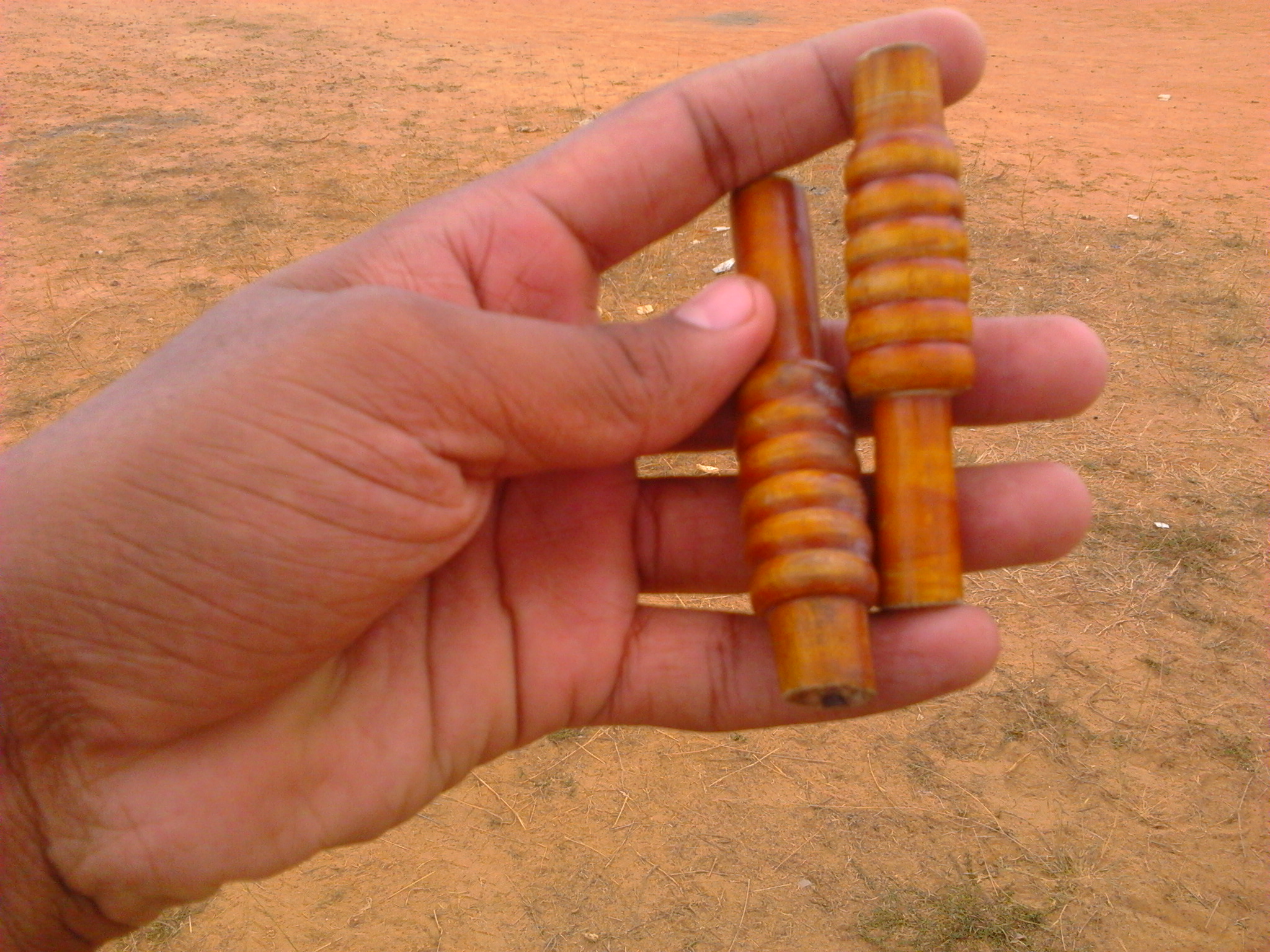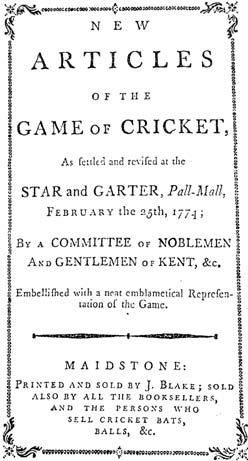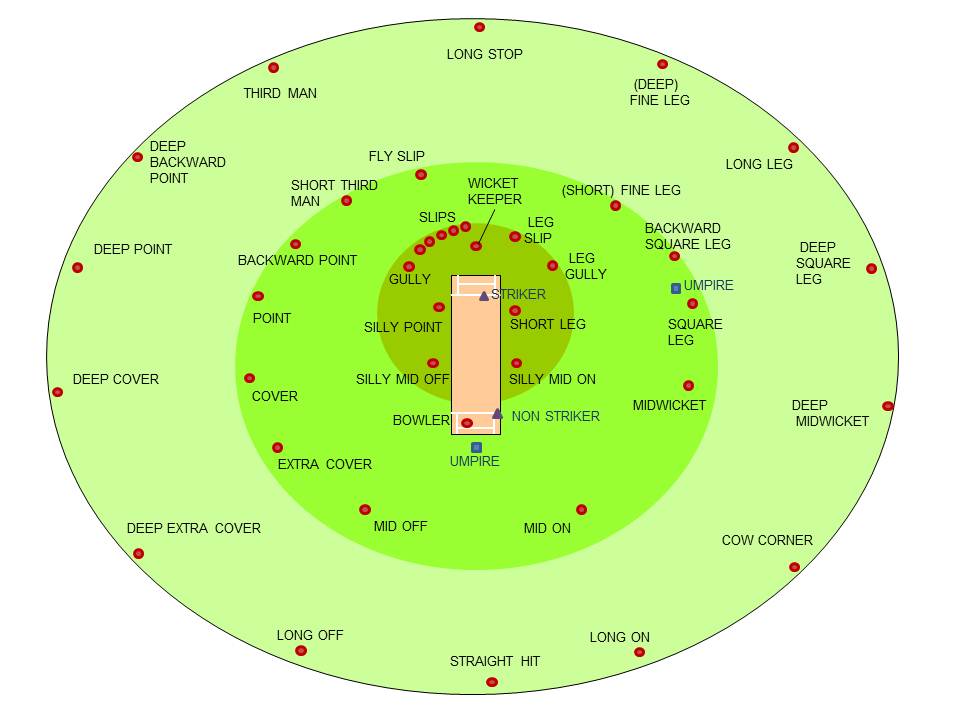|
Bail (cricket)
In the sport of cricket, a bail is one of the two smaller sticks placed on top of the three stumps to form a wicket. The bails are used to determine when the wicket is ''broken'' or '' put down'', which in turn is one of the critical factors in determining whether a batsman is out bowled, stumped, run out or hit wicket. The wicket is considered to be broken if one or both of the bails fall from the stumps, or a stump is struck out of the ground, by: *the ball, *the striking batsman's bat, or any part of the striker's body or clothing (even if it falls off), or *a fielder with the hand or arm holding the ball. This means, for example, that if the ball hits the wicket directly from the bowler's delivery, the batsman is only out bowled if a bail falls off, so a ball can actually brush or rest against the stumps without the batsman being dismissed (as long as the bail remains in its groove). If a bail falls off the stumps for any other reason while the ball is still in play, a ... [...More Info...] [...Related Items...] OR: [Wikipedia] [Google] [Baidu] |
Sport
Sport pertains to any form of competitive physical activity or game that aims to use, maintain, or improve physical ability and skills while providing enjoyment to participants and, in some cases, entertainment to spectators. Sports can, through casual or organized participation, improve participants' physical health. Hundreds of sports exist, from those between single contestants, through to those with hundreds of simultaneous participants, either in teams or competing as individuals. In certain sports such as racing, many contestants may compete, simultaneously or consecutively, with one winner; in others, the contest (a ''match'') is between two sides, each attempting to exceed the other. Some sports allow a "tie" or "draw", in which there is no single winner; others provide tie-breaking methods to ensure one winner and one loser. A number of contests may be arranged in a tournament producing a champion. Many sports leagues make an annual champion by arranging games ... [...More Info...] [...Related Items...] OR: [Wikipedia] [Google] [Baidu] |
Bowler (cricket)
Bowling, in cricket, is the action of propelling the ball toward the wicket defended by a batter. A player skilled at bowling is called a ''bowler''; a bowler who is also a competent batter is known as an all-rounder. Bowling the ball is distinguished from ''throwing'' the ball by a strictly specified biomechanical definition, which restricts the angle of extension of the elbow. A single act of bowling the ball towards the batsman is called a ''ball'' or a '' delivery''. Bowlers bowl deliveries in sets of six, called an '' over''. Once a bowler has bowled an over, a teammate will bowl an over from the other end of the pitch. The Laws of Cricket govern how a ball must be bowled. If a ball is bowled illegally, an umpire will rule it a ''no-ball''. If a ball is bowled too wide of the striker for the batsman to be able to play at it with a proper cricket shot, the bowler's end umpire will rule it a '' wide''. There are different types of bowlers, from fast bowlers, whose primary ... [...More Info...] [...Related Items...] OR: [Wikipedia] [Google] [Baidu] |
Cricket Terminology
This is a general glossary of the terminology used in the sport of cricket. Where words in a sentence are also defined elsewhere in this article, they appear in italics. Certain aspects of cricket terminology are explained in more detail in cricket statistics and the naming of fielding positions is explained at fielding (cricket). Cricket is known for its rich terminology.''Glossary of cricket terms'' from the England Cricket Board retrieved 13 May 2008Cricket Academy – Glossary from |
Cricket Equipment
Cricket clothing and equipment is regulated by the laws of cricket. Cricket whites, sometimes called flannels, are the loose fitting clothes which are worn while playing cricket so as not to restrict the player's movement. Use of protective equipment, such as cricket helmets, gloves and pads, is also regulated. Clothing and protective gear * Collared shirt (white in tests domestic; as per team kit in one day formats nternational with short or long sleeves depending on the climate or personal preference. * Long trousers (white in tests and domestic; as per team kit in one day formats nternational. * Jumper (a woollen pullover, if necessary). This is usually a vest. * Sun hat, cricket cap or baseball cap. * Spiked shoes to increase traction. *Protective equipment ** Jockstrap with cup pocket into which a "box", or protective cup, is inserted and held in place. ** Abdominal guard or "box" or an Guard for batters and wicket-keepers (often referred to as a ''cup'', ''box'' or ''a ... [...More Info...] [...Related Items...] OR: [Wikipedia] [Google] [Baidu] |
Cricket Clothing And Equipment
Cricket clothing and equipment is regulated by the laws of cricket. Cricket whites, sometimes called flannels, are the loose fitting clothes which are worn while playing cricket so as not to restrict the player's movement. Use of protective equipment, such as cricket helmets, gloves and pads, is also regulated. Clothing and protective gear * Collared shirt (white in tests domestic; as per team kit in one day formats[international]) with short or long sleeves depending on the climate or personal preference. * Long trousers (Cricket whites, white in tests and domestic; as per team kit in one day formats[international]). * Jumper (a woollen pullover, if necessary). This is usually a vest. * Sun hat, cricket cap or baseball cap. * Spiked shoes to increase traction. *Protective equipment ** Jockstrap with cup pocket into which a "box", or protective cup, is inserted and held in place. ** Jockstrap#Protective cup, Abdominal guard or "box" or an Guard for batters and wicket-keepers ( ... [...More Info...] [...Related Items...] OR: [Wikipedia] [Google] [Baidu] |
Laws Of Cricket
The ''Laws of Cricket'' is a code which specifies the rules of the game of cricket worldwide. The earliest known code was drafted in 1744 and, since 1788, it has been owned and maintained by its custodian, the Marylebone Cricket Club (MCC) in London. There are currently 42 Laws (always written with a capital "L") which outline all aspects of how the game is to be played. MCC has re-coded the Laws six times, the seventh and latest code being released in October 2017. The 2nd edition of the 2017 Code came into force on 1 April 2019. The first six codes prior to 2017 were all subject to interim revisions and so exist in more than one version. MCC is a private club which was formerly cricket's official governing body, a role now fulfilled by the International Cricket Council (ICC). MCC retains copyright in the Laws and only the MCC may change the Laws, although usually this is only done after close consultation with the ICC and other interested parties such as the Association of Crick ... [...More Info...] [...Related Items...] OR: [Wikipedia] [Google] [Baidu] |
Cricket Bails
Cricket is a bat-and-ball game played between two teams of eleven players on a field at the centre of which is a pitch with a wicket at each end, each comprising two bails balanced on three stumps. The batting side scores runs by striking the ball bowled at one of the wickets with the bat and then running between the wickets, while the bowling and fielding side tries to prevent this (by preventing the ball from leaving the field, and getting the ball to either wicket) and dismiss each batter (so they are "out"). Means of dismissal include being bowled, when the ball hits the stumps and dislodges the bails, and by the fielding side either catching the ball after it is hit by the bat, but before it hits the ground, or hitting a wicket with the ball before a batter can cross the crease in front of the wicket. When ten batters have been dismissed, the innings ends and the teams swap roles. The game is adjudicated by two umpires, aided by a third umpire and match referee ... [...More Info...] [...Related Items...] OR: [Wikipedia] [Google] [Baidu] |
Umpire Decision Review System
The Decision Review System (DRS), formerly known as the Umpire Decision Review System (UDRS), is a technology-based system used in cricket to assist the match officials in their decision-making. On-field umpires may choose to consult with the third umpire (known as an Umpire Review), and players may request that the third umpire consider a decision of the on-field umpires (known as a Player Review). The main elements that have been used are television replays, technology that tracks the path of the ball and predicts what it would have done, microphones to detect small sounds made as the ball hits bat or pad, and infra-red imaging to detect temperature changes as the ball hits the bat or pad. While on-field Test match umpires have been able to refer some decisions to a third umpire since November 1992, the formal DRS system to add Player Reviews was first used in a Test match in 2008, first used in a One Day International (ODI) in January 2011, and used in a Twenty20 Internationa ... [...More Info...] [...Related Items...] OR: [Wikipedia] [Google] [Baidu] |
Hawk-Eye
Hawk-Eye is a computer vision system used in numerous sports such as cricket, tennis, Gaelic football, badminton, hurling, rugby union, association football and volleyball, to visually track the trajectory of the ball and display a profile of its statistically most likely path as a moving image. The onscreen representation of the trajectory results is called Shot Spot. The Sony-owned Hawk-Eye system was developed in the United Kingdom by Paul Hawkins. The system was originally implemented in 2000 for television purposes in cricket. The system works via six (sometimes seven) high-performance cameras, normally positioned on the underside of the stadium roof, which track the ball from different angles. The video from the six cameras is then triangulated and combined to create a three-dimensional representation of the ball's trajectory. Hawk-Eye is not infallible, but is advertised to be accurate to within 3.6 millimetres and generally trusted as an impartial second opinion in sp ... [...More Info...] [...Related Items...] OR: [Wikipedia] [Google] [Baidu] |
Umpire (cricket)
In cricket, an umpire (from the Old French ''nompere'' meaning not a peer, i.e. not a member of one of the teams, impartial) is a person who has the authority to make decisions about events on the cricket field according to the '' Laws of Cricket''. Besides making decisions about legality of delivery, appeals for wickets and general conduct of the Game in a legal manner, the umpire also keeps a record of the deliveries and announces the completion of an over. A cricket umpire is not to be confused with the referee who usually presides only over international matches and makes no decisions affecting the outcome of the game. Overview Traditionally, cricket matches have two umpires on the field, one standing at the end where the bowler delivers the ball (bowler's end), and one directly opposite the facing batsman (usually, but not always, at square leg). However, in the modern game, there may be more than two umpires; for example Test Matches have four: two on-field umpires, a ... [...More Info...] [...Related Items...] OR: [Wikipedia] [Google] [Baidu] |
Lignum Vitae
Lignum vitae () is a wood, also called guayacan or guaiacum, and in parts of Europe known as Pockholz or pokhout, from trees of the genus ''Guaiacum''. The trees are indigenous to the Caribbean and the northern coast of South America (e.g: Colombia and Venezuela) and have been an important export crop to Europe since the beginning of the 16th century. The wood was once very important for applications requiring a material with its extraordinary combination of strength, toughness, and density. It is also the national tree of the Bahamas, and the Jamaican national flower. The wood is obtained chiefly from ''Guaiacum officinale'' and ''Guaiacum sanctum'', both small, slow-growing trees. All species of the genus ''Guaiacum'' are now listed in Appendix II of CITES (the Convention on International Trade in Endangered Species of Wild Fauna and Flora) as potentially endangered species. ''G. sanctum'' is listed as Near Threatened by the IUCN Red List. Demand for the wood has been red ... [...More Info...] [...Related Items...] OR: [Wikipedia] [Google] [Baidu] |
Cylinder (geometry)
A cylinder (from ) has traditionally been a three-dimensional solid, one of the most basic of curvilinear geometric shapes. In elementary geometry, it is considered a prism with a circle as its base. A cylinder may also be defined as an infinite curvilinear surface in various modern branches of geometry and topology. The shift in the basic meaning—solid versus surface (as in ball and sphere)—has created some ambiguity with terminology. The two concepts may be distinguished by referring to solid cylinders and cylindrical surfaces. In the literature the unadorned term cylinder could refer to either of these or to an even more specialized object, the ''right circular cylinder''. Types The definitions and results in this section are taken from the 1913 text ''Plane and Solid Geometry'' by George Wentworth and David Eugene Smith . A ' is a surface consisting of all the points on all the lines which are parallel to a given line and which pass through a fixed plane curve in ... [...More Info...] [...Related Items...] OR: [Wikipedia] [Google] [Baidu] |







